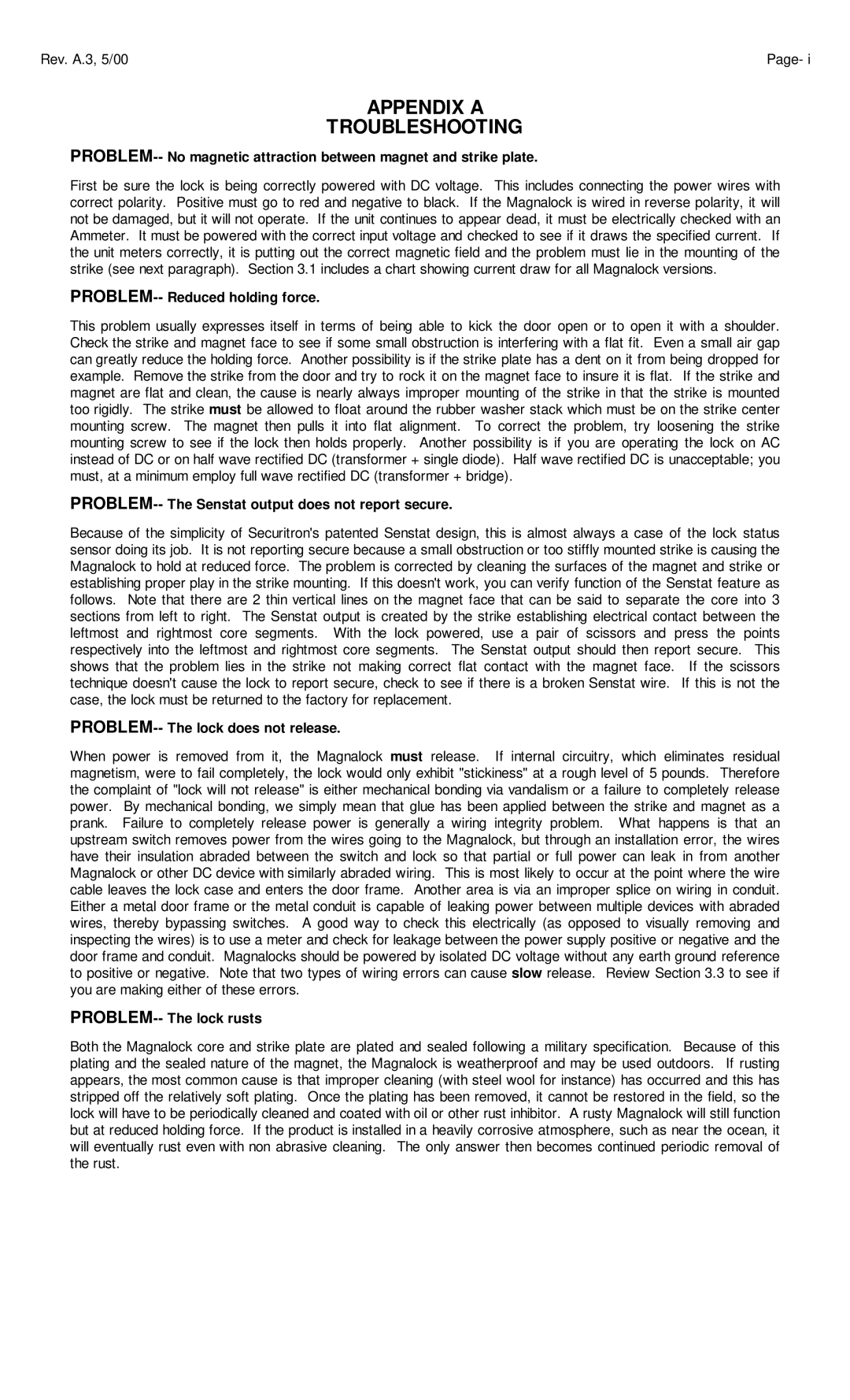Rev. A.3, 5/00 | Page- i |
APPENDIX A
TROUBLESHOOTING
First be sure the lock is being correctly powered with DC voltage. This includes connecting the power wires with correct polarity. Positive must go to red and negative to black. If the Magnalock is wired in reverse polarity, it will not be damaged, but it will not operate. If the unit continues to appear dead, it must be electrically checked with an Ammeter. It must be powered with the correct input voltage and checked to see if it draws the specified current. If the unit meters correctly, it is putting out the correct magnetic field and the problem must lie in the mounting of the strike (see next paragraph). Section 3.1 includes a chart showing current draw for all Magnalock versions.
PROBLEM-- Reduced holding force.
This problem usually expresses itself in terms of being able to kick the door open or to open it with a shoulder. Check the strike and magnet face to see if some small obstruction is interfering with a flat fit. Even a small air gap can greatly reduce the holding force. Another possibility is if the strike plate has a dent on it from being dropped for example. Remove the strike from the door and try to rock it on the magnet face to insure it is flat. If the strike and magnet are flat and clean, the cause is nearly always improper mounting of the strike in that the strike is mounted too rigidly. The strike must be allowed to float around the rubber washer stack which must be on the strike center mounting screw. The magnet then pulls it into flat alignment. To correct the problem, try loosening the strike mounting screw to see if the lock then holds properly. Another possibility is if you are operating the lock on AC instead of DC or on half wave rectified DC (transformer + single diode). Half wave rectified DC is unacceptable; you must, at a minimum employ full wave rectified DC (transformer + bridge).
PROBLEM-- The Senstat output does not report secure.
Because of the simplicity of Securitron's patented Senstat design, this is almost always a case of the lock status sensor doing its job. It is not reporting secure because a small obstruction or too stiffly mounted strike is causing the Magnalock to hold at reduced force. The problem is corrected by cleaning the surfaces of the magnet and strike or establishing proper play in the strike mounting. If this doesn't work, you can verify function of the Senstat feature as follows. Note that there are 2 thin vertical lines on the magnet face that can be said to separate the core into 3 sections from left to right. The Senstat output is created by the strike establishing electrical contact between the leftmost and rightmost core segments. With the lock powered, use a pair of scissors and press the points respectively into the leftmost and rightmost core segments. The Senstat output should then report secure. This shows that the problem lies in the strike not making correct flat contact with the magnet face. If the scissors technique doesn't cause the lock to report secure, check to see if there is a broken Senstat wire. If this is not the case, the lock must be returned to the factory for replacement.
PROBLEM-- The lock does not release.
When power is removed from it, the Magnalock must release. If internal circuitry, which eliminates residual magnetism, were to fail completely, the lock would only exhibit "stickiness" at a rough level of 5 pounds. Therefore the complaint of "lock will not release" is either mechanical bonding via vandalism or a failure to completely release power. By mechanical bonding, we simply mean that glue has been applied between the strike and magnet as a prank. Failure to completely release power is generally a wiring integrity problem. What happens is that an upstream switch removes power from the wires going to the Magnalock, but through an installation error, the wires have their insulation abraded between the switch and lock so that partial or full power can leak in from another Magnalock or other DC device with similarly abraded wiring. This is most likely to occur at the point where the wire cable leaves the lock case and enters the door frame. Another area is via an improper splice on wiring in conduit. Either a metal door frame or the metal conduit is capable of leaking power between multiple devices with abraded wires, thereby bypassing switches. A good way to check this electrically (as opposed to visually removing and inspecting the wires) is to use a meter and check for leakage between the power supply positive or negative and the door frame and conduit. Magnalocks should be powered by isolated DC voltage without any earth ground reference to positive or negative. Note that two types of wiring errors can cause slow release. Review Section 3.3 to see if you are making either of these errors.
PROBLEM-- The lock rusts
Both the Magnalock core and strike plate are plated and sealed following a military specification. Because of this plating and the sealed nature of the magnet, the Magnalock is weatherproof and may be used outdoors. If rusting appears, the most common cause is that improper cleaning (with steel wool for instance) has occurred and this has stripped off the relatively soft plating. Once the plating has been removed, it cannot be restored in the field, so the lock will have to be periodically cleaned and coated with oil or other rust inhibitor. A rusty Magnalock will still function but at reduced holding force. If the product is installed in a heavily corrosive atmosphere, such as near the ocean, it will eventually rust even with non abrasive cleaning. The only answer then becomes continued periodic removal of the rust.
